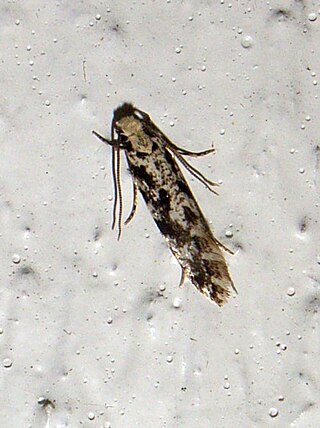Related Research Articles
Cimitra is a genus of moths belonging to the family of Tineidae. Most species of this genus are found in Africa but Cimitra sechusella Walker, 1864 is found in Southeast Asia.
Hapsiferona is a genus of moths belonging to the family Tineidae.

Tiquadra is a genus of moths belonging to the family Tineidae.

Agnathosia is a genus of moths belonging to the family Tineidae.
Eudarcia is a genus of moths belonging to the family Tineidae.

Infurcitinea is a genus of the fungus moth family, Tineidae. Therein, it belongs to the Meessiinae, one of the larger fungus moth subfamilies.
Scalmatica is a genus of moths belonging to the family Tineidae.

Ateliotum is a small genus of the fungus moth family, Tineidae. It belongs to the subfamily Myrmecozelinae.
Janseana is a genus of moths belonging to the family Tineidae.

Nemapogon is a genus of the fungus moth family, Tineidae. Therein, it belongs to the subfamily Nemapogoninae. As evident by its name, it is the type genus of its subfamily.

Edosa is a genus of moths belonging to the family Tineidae.
Ceratobia is a small genus of the fungus moth family, Tineidae. Therein, it belongs to the subfamily Tineinae.
Crypsithyris is a genus of moths belonging to the family Tineidae.

Proterospastis is a genus of moths belonging to the family Tineidae.
Reisserita is a genus of moths belonging to the family Tineidae.
Miarotagmata is a genus of moths belonging to the family Tineidae. It contains only one species, Miarotagmata penetrata, which is found in South Africa and Zimbabwe.
Criticonoma is a genus of moths belonging to the family Tineidae.
Organodesma is a genus of moths belonging to the family Tineidae. The genus was described in 1965 by Hungarian entomologist László Anthony Gozmány.